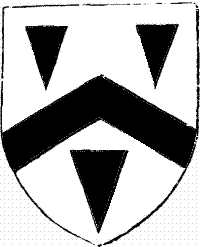|
Samuel Pegge
Samuel Pegge "the Elder" (5 November 1704 – 14 February 1796) was an English antiquary and clergyman. Born at Chesterfield, Derbyshire, he was the son of Christopher Pegge[2] and his wife Gertrude, daughter of Francis Stephenson of Unstone, near Chesterfield. Christopher Pegge (died 1723) belonged to a family that had lived for several generations at Osmaston, near Ashbourne, Derbyshire, was a woollen dealer in Derby and later a lead merchant in Chesterfield. Samuel's father was Mayor of Chesterfield three times.[3] Samuel published an important study on the Roman roads of Derbyshire as well as notes which his son, also Samuel, continued on the subject of Derbyshire words and phrases.[4] EducationSamuel Pegge was educated at Chesterfield and he became a pensioner and scholar of St. John's College, Cambridge, in 1722.[5] He graduated B.A. 1725, M.A. 1729. He was elected to a lay fellowship on the Beresford foundation of his college on 21 March 1726, but was removed in favour of Michael Burton (afterwards vice-master of St. John's), who claimed founder's kin. Pegge was then made an honorary fellow, and in 1729 was elected a "Platt" fellow of St. John's. In 1730 he was elected a member of the Spalding Society, to which he contributed some papers, and from 1730 to 1732 belonged to the Zodiac Club, a college literary society consisting of twelve members denominated by the signs of the zodiac. Pegge was the original Mars.[3] Vicar and antiquary Pegge was ordained in 1729, and in 1730 became curate to Dr. John Lynch at Sundridge in Kent. On 6 December 1731 he became the vicar of Godmersham, Kent, where he lived for about twenty years, writing on antiquities and collecting books and coins. From 1749 to 1751 he lived at Surrenden, again in Kent, as tutor to the son of Sir Edward Dering. In 1751 he was elected fellow of the Society of Antiquaries, and in the same year was inducted into the rectory of Old Whittington, near Chesterfield, exchanging Godmersham for the rectory of Brinhill (or Brindle), Lancashire. On 22 October 1758 he exchanged Brinhill for the vicarage of Heath, near Whittington, holding Heath together with Whittington until his death. In 1765 he was presented to the perpetual curacy of Wingerworth, near Whittington. He was a prebendary of Lichfield (1757–1796), and in 1772 was collated to a stall in Lincoln Cathedral. In 1791 he was created LL.D. by the University of Oxford. He died, after a fortnight's illness, on 14 February 1796 at the age of 92. He was buried in the chancel at Whittington, where a mural tablet was installed. His small collection of English coins and medals were sold by auction on 23 March 1797.[3] Family On 13 April 1732, Pegge married Anne (d. July 1746), daughter of Benjamin Clarke of Stanley, near Wakefield, Yorkshire, and they had three children : Christopher (died in infancy), Samuel (the younger), and Anna Katharine, wife of the Rev. John Bourne of Spital, near Chesterfield. A portrait of Pegge, drawn by Gustavus Brander, and engraved by James Basire, is prefixed to Pegge's Forme of Cury (see illustration above) however there was an oil painting of him (reputed a better likeness) by Elias Needham.[3] ContributionsPegge contributed to the first ten volumes of the Archaeologia memoirs on a great variety of topics, such as Anglo-Saxon jewellery ; the introduction of the vine into Britain; the stylus: King Alfred; the bull-running at Tutbury; the horn as a charter or instrument of conveyance; shoeing horses among the ancients ; cock-fighting; the right of sanctuary; the manner of King John's death; Kit's Coty House ; the commencement of day among the Saxons and Britons; "the mistaken opinion that Ireland and the Isle of Thanet are void of Serpents and prehistoric remains generally". He wrote seven memoirs in the Bibliotheca Topographica Britannica, including The Story of Guy, Earl of Warwick (1783); The History of Eccleshall Manor (1784); The Roman Roads of Derbyshire (1784);[4] The Textus Roffensis (1784) ; History of Bolsover and Peak Castles, Derbyshire (1783). He also wrote a large number of articles for the Gentleman's Magazine from 1746 to 1795, signing himself "Paul Gemsege" – an anagram of Samuel Pegge), T. Row ( = The Rector Of Whittington), and "L. E." ( = [Samue]L [Pegg]E). While vicar of Godmersham Pegge made collections relating to Kent, including a Monasticon Cantianum in two folio manuscript volumes, and an account of the antiquities of Wye. He compiled a manuscript Lexicon Xenophonticum, and possessed various lexicons annotated by himself, as well as two volumes of collections in English history.[3] Published works
References
External linksWikimedia Commons has media related to Samuel Pegge. |
||||||||||||||||||
